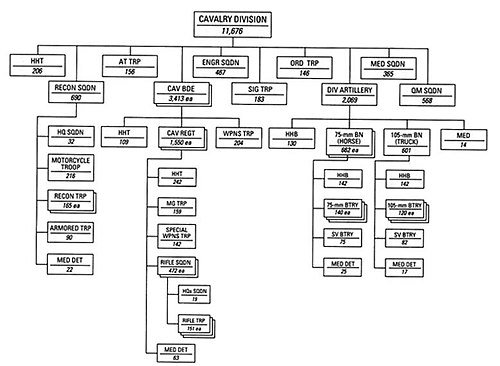History
The 61st Cavalry Division was constituted in the Organized Reserve on 15 October 1921, allotted to the Second Corps Area, and assigned to the Fourth Army. The division headquarters was initiated in December 1921 by Major Frederick S. Snyder at the Federal Building in Rochester, New York. The headquarters was relocated to the Army Building in New York City in January 1922 and finally to 39 Whitehall Street in New York City in April 1922. To maintain communications with the officers of the division, Colonel William F.H. Godson, the division chief of staff, established a newsletter titled the “Forager” after the division’s nickname. In accordance with early mobilization plans, the Syracuse Concentration Area was designated as the division’s mobilization station.
The division tables of organization remained unchanged from its formation until 1 July 1929 when the machine gun squadrons were deleted. The 151st Machine Gun Squadron was reorganized and redesignated as the 461st Armored Car Squadron, while the personnel of the 152nd Machine Gun Squadron were reassigned to one of the cavalry regiments in New York City. Other changes to the division organization were the addition of the 461st Tank Company (Light), and the expansion of the 461st Field Artillery Battalion into a regiment (and concurrent redesignation as the 861st). Additionally, when the field armies were activated and army areas reallocated in 1933, the division was relieved from the Fourth Army and assigned to the First Army. The 61st Cavalry Division boasted its share of interesting personalities, some of whom gained fame later on in World War II. For example, Major Terry de la Mesa Allen, later to become the first commanding general of the 2nd Cavalry Division, and also command the famed 1st Infantry Division, the “Big Red One,” in World War II, was the executive officer of the 303rd Cavalry in New York City. The first commanding officer of the 301st Cavalry Regiment was Colonel William J. "Wild Bill" Donovan. Colonel Donovan won the Medal of Honor in World War I and was the U.S. District Attorney in Syracuse. However, Col. Donovan would become even more famous for organizing and heading the Office of Strategic Services (OSS) during World War II, the forerunner of the Central Intelligence Agency (CIA).
The Inactive Training Period for 61st Cavalry Division units usually ran September to May. The 151st Cavalry Brigade and other “upstate” units conducted their training events on Tuesday evenings, and were the first in the division to begin a regular schedule of marksmanship training. In fact, the 151st Machine Gun Squadron competed regularly in rifle matches against the 26th Infantry Regiment at Plattsburg Barracks, though they rarely bested the Regulars. The division headquarters, 152nd Cavalry Brigade, and other New York City units had their inactive meetings on the first and third Mondays of each month at the Army-Navy Club in Manhattan. Riding classes were conducted on Thursday evenings at the 101st Cavalry Regiment Armory and correspondence courses were done on the officers' own time. The division held consolidated summer training camps for the first two years (1922–23) at Camp Dix, New Jersey. After that, the division's support units generally went to camps for their respective arm or service. For example, the 401st Engineers usually trained with the 1st Division's 1st Engineer Regiment at Fort DuPont, Delaware, the 461st Field Artillery Battalion trained with the 2nd Battalion, 7th Field Artillery Regiment, at Madison Barracks, New York, and the 361st Medical Squadron trained with the 1st Medical Regiment at Carlisle Barracks, Pennsylvania.
From 1924 to 1934, the cavalry units trained at Fort Ethan Allen, Vermont. The training plan was normally developed by the division’s Regular Army instructors and executed with the assistance of the 1st Squadron, 3rd Cavalry, and the 7th Field Artillery, both stationed at Fort Ethan Allen. In 1935, however, the 152nd Cavalry Brigade was sent to train at Fort Myer, Virginia, with the 62nd Cavalry Division and the 3rd Cavalry. The event was so successful that the whole division traveled down to train with the 62nd Division in 1937 and 1939. For the intervening years of 1936 and 1938, the division went to Jericho, Vermont, near Fort Ethan Allen, to train. The division staff also had the opportunity to function as a staff during several Second Corps Area and First Army command post exercises held in 1929, 1931, 1934, and 1936. Due to the lack of equipment and enlisted personnel, units of the 61st Cavalry Division did not participate as organized units in the First Army maneuvers of 1935, 1939, and 1940. However, hundreds of individual officers and many enlisted men from the 61st participated as umpires or by being assigned to Regular Army or National Guard cavalry units to bring them up to authorized war strength. The 1940 maneuver in upstate New York was the division’s last major training event, for although the 61st was not officially disbanded until 30 January 1942, it had almost ceased to exist by then, with most of the assigned personnel already having been called to active duty and assigned to Regular Army and National Guard units, leaving only a shell of the former divisional organization. [1]

